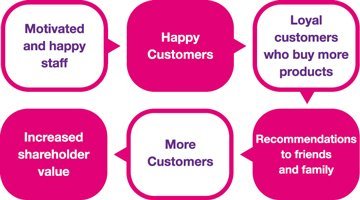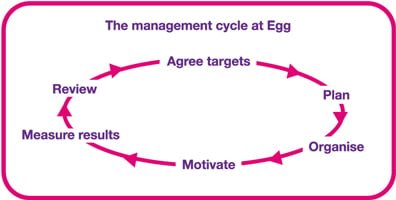
Egg is the world’s largest pure online bank, established in 1998. It has a reputation for innovation in financial services and was set up in response to consumer demand for a more flexible approach to banking.
Today it has more than 3.7 million customers. Egg is best known for its credit card business, but it also offers loans, savings accounts, investments, mortgages and insurance.
Benefits of motivating people

Egg’s enduring purpose is ‘to revolutionise customers’ experience of financial services driven through unleashing the power of people’. This is like a mission statement, in that it defines the way the company carries out its business. Egg knows its performance will determine its success in winning and keeping the confidence of its customers.

It is apparent from Egg’s enduring purpose that it believes in the ‘power of people‘. First-rate performances by Egg people offer a first-rate service to its customers.
When customers receive a great service, they will tend to buy more. This in turn will lead to greater shareholder value. Egg believes it is advantageous to build a strategy of motivation into its culture. Motivation is seen as essential and has been made part of the fabric of the company, known as ‘Egg DNA‘ (see Section 5).
What is motivation?

In essence, motivation is the art of getting people to do things because they want to, or because they see some benefit. At its most crude, motivation in the workplace is linked to pay. It has subsequently been proved that pay is not the only motivator and in certain circumstances does not act as one at all.
For Egg, motivation is about creating an environment where its people:
- Are involved in planning, performing and achieving for themselves, customers and Egg.
- Have a great relationship with their manager who knows what they are wanting to achieve in their working life.
- Feel empowered and ‘unleashed‘, so they have the power to create change, reach their potential and deliver excellent customer service.
- Enjoy their work and have opportunities to improve themselves and their role.
- Are recognised and rewarded for the effort they put into making Egg successful.
However, Egg also recognises that all the ‘hygiene factors’ which affect motivation need to be in place and work effectively. For example great emphasis is placed on creating an atmosphere which is conducive to working creatively and powerfully and ensuring that people’s salaries are paid on time.
Egg’s approach builds on much of the theory described in Section 4. Egg aims to understand its people as much as possible and to get the best out of them. By meeting the needs of the individual – and giving them ownership and the power to make decisions – Egg ensures that the needs of the business are met.

At Egg the role of the manager is vital in ensuring its people are motivated. The management cycle is continuous – managers plan and organise work. They then, in conjunction with their people, distribute the work in such a way that, wherever possible, everyone is undertaking work which motivates them and that they enjoy, and therefore delivers a better result for customers and shareholders.
Egg makes sure that each manager knows his or her own people well through training called ‘know yourself, know your people’. It recognises that every individual is unique and the way in which they behave is driven by a number of factors. Understanding how these factors can be harnessed to reach both Egg’s and the employee’s target is of utmost importance.
Motivational theory

Over the years, many theorists have tried to discover what motivates people. The most well-known are Taylor (1856-1917), Mayo (1880-1949), Maslow (1908-1970), McGregor (1906-1964) and Herzberg (1923-2000). Of course, motivation is so important that new theories are constantly being developed (Egg, for instance, uses McClelland’s Three Social Motives) but these are all built on the work of the early theorists.
Taylor – Scientific Management
The first of these is FW Taylor’s Scientific Management Theory. Taylor was an American who worked with Henry Ford and may be said to be responsible for the first production lines. He believed money was the only motivator and that there should be a ‘carrot and stick’ approach. This means that for those who worked hard enough there would be rewards, but for those who didn’t, penalties would be imposed. Other theorists realised that this was not always the way to get the best out of people.
Mayo – Hawthorne Effect
Elton Mayo did not accept that money was the only motivator and he carried out the Hawthorne Experiments at a plant in Chicago to try to discover what really drove people. His Relay Assembly Test proved that workers were inspired by directing their own work, working in teams and having a good relationship with management. He concluded that the main reason his subjects’ work rate increased was because they were being studied. Having someone show an interest in you is, in itself, a motivating factor.
He also found that people were driven when working in teams. People are also influenced by their own aspirations and by friendship groups, and managers can use these to assist in motivation. What Mayo called the psychological contract refers to the unwritten understanding between the employer and the employee – each knows what is expected of them. This can be built on to ensure that the workers and the business are reaching their potential.
Maslow – Hierarchy of Needs

AH Maslow was an American psychologist who believed that people worked in order to obtain certain things. He established a ‘hierarchy of needs’, as shown in the figure, stating that people would endeavour to reach each need in order, starting from the bottom. Once they had reached a level, they would then strive to achieve the next one.
McGregor – Theory X and Theory Y
Douglas McGregor studied how employers and employees could each have a view of work. He called the traditional way of working Theory X. Here, the employer pays the money, supervises the worker and gives instructions; the worker does the job, asks no questions and accepts the pay. This he balanced with what he called Theory Y. This is where most people are satisfied with their employment and take responsibility. McGregor believed that most workers are the Theory Y type and that if people could be treated this way, firms would be more efficient.
Herzberg – Hygiene factors
Frederick Herzberg came to similar conclusions to Mayo. Asking workers what motivated them, he ascertained that the main things were a ‘job well done’, a feeling of being appreciated, trust, responsibility and specific rewards, such as being promoted. Certain conditions, which Herzberg called ‘hygiene’ factors, were de-motivators if they were missing or inadequate. Pay and working conditions are two of the main ones, meaning that satisfactory surroundings are not necessarily motivators, but inferior environments are certainly de-motivators.
Motivation in practice

Mayo’s theories and conclusions are particularly important at Egg. He commenced from the idea that the better the relations between management and their teams, the more efficient the business would be.
Working agreeably is linked to being contented, and satisfaction comes from the employee knowing s/he is appreciated. This is why Egg places so much emphasis on managers knowing their people well in order that they enjoy their work and are putting in every effort because they want to.
Egg believes that to motivate people it is important to balance the needs and wants of the company with those of the individual.
‘I want
This refers to what the individual wants from their working life. It is discussed in a ‘Know Your People‘ conversation between the manager and the employee. This conversation is an important opportunity for the employee to talk about what motivates them, what they enjoy doing and what their future aspirations are. Egg endeavours to ensure these needs can be reached by, wherever possible, matching them into a role that takes account of what they want to achieve and thus ‘unleashing their power’.
Each person has different levels of aspiration. For example, an ambitious graduate may have different goals and needs to a part-timer with young children or someone nearing retirement. This is something each manager knows through the dialogue they have with their people. Taking this approach leads to Egg being a motivated organisation with motivated people.
‘Egg wants’
Egg believes that the aims of the company (known at Egg as the ‘Egg Game‘) can be delivered through clear responsibilities and targets (known as accountabilities and objectives). When the accountabilities and objectives have been formulated by the manager s/he will have a further conversation with each team member to agree these. They talk about what the employee brings to the job and the knowledge s/he can acquire and use.
Egg recognises that everyone has different training and development needs and ambitions which will enable them to be successful in their particular role and at Egg in general. The framework used for this is called Egg DNA and is made up of:
- The specific, special or technical skills/knowledge a person brings to the role (e.g. an accountant would need specific accountancy knowledge).
- The attitudes a person displays in relation to what is being asked of them (e.g. being passionate about the role and about what Egg is wanting to achieve).
- The non-technical skills individuals need to do their job (e.g. communicating powerfully).
Egg plans to enhance and improve these qualities and skills through training and coaching the individual to be the best they can in the role they are undertaking.
Egg hopes that motivated people who enjoy their work will encourage their family and friends to apply for jobs when they become available. It runs a scheme which rewards people financially for this called ‘Bring a Friend to Egg’.

The success of Egg is connected to the way it treats its people.
Its enduring purpose sets out what it wants to provide as an organisation and where its targets lie. This includes having satisfied and well-motivated people who strive to deliver an excellent service for customers thus achieving greater shareholder value.

By achieving these aims, both the organisation and its people get what they require. This is what Mayo described as a psychological contract- at Egg it is called ‘10/10‘.



